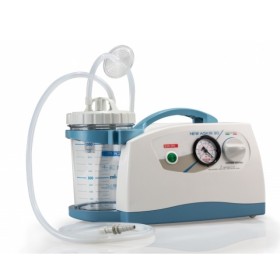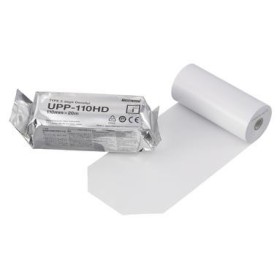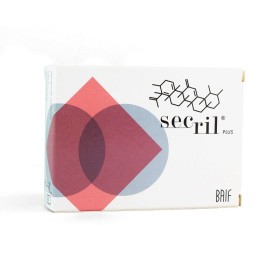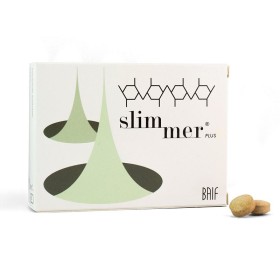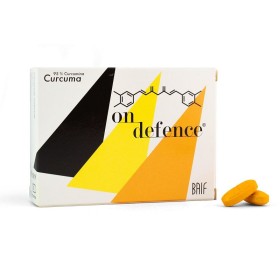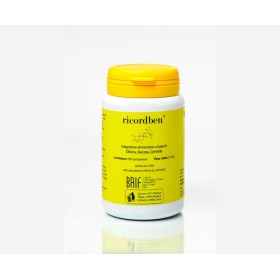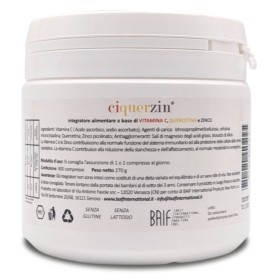Surgical aspirator NEW ASKIR 30
BAIF Supplements
There are 12 products.
OftyVit eye drops 5 ml
Shipping in 1/2 days
OFTYVIT Eye drops 5 mlOFTYVIT eye drops have been designed to create a moisturizing, lubricating, chelating and protective ophthalmic hydrogel, containing substances with an antioxidant and nourishing effect on eye tissues.The human eye can be subjected to stress due to excess oxidative phenomena (smog, strong solar radiation, artificial lighting, use of video terminals, tablets, smartphones, etc.) or due to problems related to insufficient assimilation or inta...
€9.21
Secril Plus, Supplement for Tissue Dryness - 30 tablets
Shipping in 1/2 days
Secril Plus - Supplement for Tissue Dryness - 30 tabletsSupplement for Dry Eye and Dry SkinSecril Plus is a supplement for tissue dryness based on Boswellia aimed at reducing tissue dryness disorders and relieving discomfort. Its synergistic action is the result of a combination of Boswellia, Collagen and Egg Membrane, Vitamin B6 and B12, Vitamin A and Vitamin C.Secril Plus is indicated for dry conditions as a supplement for dry eye or supplement for dry skin, t...
€11.56
Flavogin - Regulator Vessel Supplement with Ginkgo Biloba 30 Tablets
Shipping in 1/2 days
Flavogin - Regulator Vessel Supplement with Ginkgo Biloba 30 TabletsFlavogin Plus is a vessel-regulating supplement based on Ginkgo Biloba, bioflavonoids, microcrystalline cellulose, maltodextrin and rosehip.The synergy of action of its components performs a vasoregulatory action with a vasodilator effect, contributes to a correct trophism of the microcirculation, keeps the memory functions reactive and can act as an antiplatelet agentSpecifications:...
€11.58
Neomyrt MZ - Blueberry Eye Supplement 30 Tablets
Shipping in 1/2 days
Neomyrt MZ - Blueberry Eye Supplement 30 TabletsNeomyrt MZ is a blueberry eye supplement that promotes the well-being of vision.Notified to the Ministry of Health, available in 30 tablets; based on plant extracts of blueberry, centella, bioflavonoids, rutin, vitamin C, selenium, zinc and melatonin.It is useful for improving visual function, maintaining normal eye well-being and, thanks to its antioxidant action, protecting eye tissues from the harmful act...
€11.58
Slimmer plus 45 tablets
Shipping in 1/2 days
Slimmer plus is a dietary supplement for body weight balance composed of plant extracts, such as Opuntia, Ononide, Pineapple, Horsetail, Birch, Butcher's Broom, Coleus. The combination of these elements helps to drain fluids and achieve an optimal balance of body weight.The Slimmer plus food supplement contains plant extracts, which synergistically act to compensate for imbalances due to insufficient dietary intake. In 45 tablets, it is a product notified by the Minist...
€12.32
OnDefence 30 compresse
Shipping in 3/5 days.
Il nuovo livello di assorbimento e purezza della CurcuminaOndefence è un integratore alimentare a base di Curcuma alla massima titolazione del suo principio attivo Curcumina. Grazie alla sua speciale formulazione, alla purezza e sinergia dei suoi ingredienti, permette alla Curcumina di venire quasi interamente assorbita ed esplicare le sue notevoli proprietà.La presenza di Bioperina (un estratto purissimo del pepe nero a base dell’alcaloide piperina), oltre ...
€16.50
Berart Plus 30 tablets with Berberine, Silymarin and Amaranth
Shipping in 1/2 days
Berart plus is a food supplement based on berberine, amaranth, BPF Bergamot, coenzyme Q10, folic acid, lutein, silymarin.The synergy of action of its components has been studied to carry out an antioxidant, digestive and hepatic activity. Amaranth contributes to cholesterol metabolism- Regulates cardiovascular function- Promotes carbohydrate and cholesterol metabolism- Has an antioxidant activity- Promotes digestive functionWhat is Berart plus
€16.50
Ricordben, supplement for mental well-being and relaxation 90 tablets
Shipping in 1/2 days
Ricordben is a food supplement based on Bacopa, Clitoria and Centella, notified to the Ministry of Health, 90 tablets, based on plant extracts in order to improve mental well-being, memory, learning and states of anxiety and depression.Available in packs of 90 tablets.Specifications:There is a link between stre...
€28.24
Prendak2 150 tablets containing vitamins A, C, D3 and K2
Shipping in 1/2 days
prendak2 is a dietary supplement useful for bone and cardiovascular health based on vitamins A, C, D3 and K2.prendak2 is a dietary supplement based on vitamins A, C, D3 and K2 These vitamins are beneficial for bone and cardiovascular health.prendak2 is the result of recent discoveries on the countless properties of vitamin K2 in synergy with vitamin D3 and vitamin A.Vitamin K2 plays numerous fundamental roles in health, and in particular it is involved in...
€30.80
Pigepil - Prostate food supplement with zinc and selenium - 90 tablets
Shipping in 1/2 days
PIGEPILPigepil is a food supplement for the prostate based on Zinc, Selenium and extracts of Serenoa, Epilobium and Pigeum useful for promoting and maintaining the physiological function of the prostate and urinary tract. The synergistic action of the natural ingredients in Pigepil can be useful in cases of prostatitis, prostatic enlargement and benign prostatic hyperplasia.Pack size of 90 tablets.Net weight 58.5 g
€30.80
Chelarmet Plus 150 tablets, antioxidant and chelating food supplement
Shipping in 1/2 days
Chelarmet plus is a dietary supplement based on reduced L-Glutathione, N-Acetylcysteine (NAC) and Selenium, ingredients that help protect cells from oxidative stress.Chelarmet plus is an innovative product, as it combines the antioxidant and chelating properties of its components, obtaining a synergy that is essential to counteract oxidative stress caused by free radicals.Contents:150 tablets Directions:Glutathione is the most ...
€31.46
Ciquerzin 300 tablets
Shipping in 3/5 days.
ciquerzin is an antioxidant food supplement based on Quercetin, Vitamin C and Zinc.Thanks to the synergy of action of the ingredients known for their antioxidant and immunomodulating activity, Ciquerzin also guarantees an immunomodulating and vasoprotective action, as well as helping to promote the well-being of the skin.Packaging: 300 tabletsCiquerzin is an anti-oxidant food supplement that combines three essential ingredients for the fu...
€37.10

